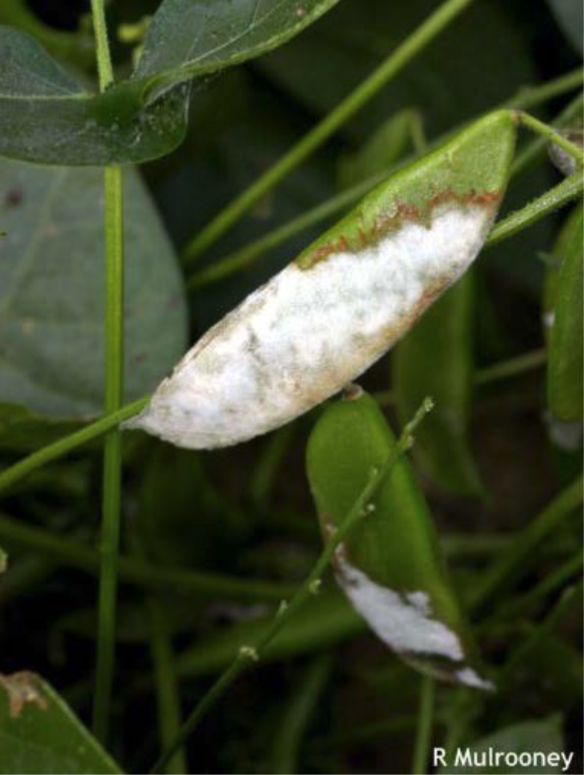
Fact Sheets And Publications

Downy Mildew on Lima Bean
Date Published:
Author(s): Andrew Kness, M.Sc. Extension Research Assistant
Nathan Kleczewski, Ph.D. Extension Plant Pathologist
Kathryne Everts, Ph.D.
Extension Vegetable Plant Pathologist
Downy mildew of lima bean, caused by the oomycete, Phytophthora phaseoli, is a common disease in Delaware production areas. Proper identification and management of the disease is critical for protecting lima bean yields. This publication will review how to correctly identify the disease, describe its lifecycle, and outline management options for growers.
Disease Identification
Scout fields in late summer/early fall when lima beans begin to flower. P. phaseoli often infects pods and racemes of lima bean; rarely does it infect leaves. The pathogen prefers young, actively expanding tissue. The pathogen appears as a dense, cottony white mat on pods and racemes (Figure 1). Pods infected with P. phaseoli often exhibit a brown to red colored margin around the area of infection, which is diagnostic of downy mildew. Pods eventually become dry and shrivel. Pods and racemes located anywhere on the plant may be infected, but infection is typically most severe on pods low on the plant and deep in the canopy.

Disease Cycle
Oospores, which are the sexually produced spores, are the chief overwintering and survival structure for P. phaseoli. Oospores will germinate and infect lima bean when environmental conditions are favorable, usually occurring during the cooler, wetter periods of late August through September in Delaware. Fields that receive greater than 1.2 inches of rain within a week (heavy dews will reduce the amount of rain needed for infection), coupled with average daily temperatures less than 78°F favor infection [1].
Once an infection has been established, secondary inoculum in the form of asexually produced sporangia and zoospores can further spread the disease throughout the field, or to new fields. Spread of the disease occurs through wind and water dispersal of sporangia and zoospores. Temperatures greater than 90°F will stop the disease cycle and require the environmental conditions outlined above to be met again in order to restart the cycle, although current research suggests that races E and F can tolerate temperatures greater than 96 degrees Fahrenheit [2].
Management
Yield loss from downy mildew can be significant if weather conditions become favorable for disease development and if the disease is not managed properly. Early detection of downy mildew and preventative actions are critical for managing this disease, and if the disease is detected in one field, it may be necessary to treat all lima bean fields in the area since the pathogen is easily wind-dispersed. Managing downy mildew of lima bean is best achieved through planting resistant varieties and timely fungicide applications.
Resistant Cultivars
The most effective management stradegy is to plant resistant lima bean varieties. Race F of P. phaseoli was first observed in 2000 [2] and is now the predominant race in Delaware. Race E is occasionally detected; however, its last detection was in 2006. Plant race F resistant varieties whenever possible. There are currently no varieties with resistance to both race E and F. Fordhook varieties are susceptible to all races of the pathogen.
Crop Rotation
P. phaseoli has a very narrow host range that is restricted to lima bean [3], therefore crop rotation options are numerous. However, crop rotations alone will not eradicate the pathogen since it readily spreads from field to field and has the ability to overwinter from year to year.
Fungicide Application
Fungicide applications are important for protecting lima bean varieties that are susceptible to the disease. Fungicide applications are only recommended at or after flowering when weather conditions favor disease. Preventative applications of a fixed copper fungicide or labeled phosphonate fungicide such as Phostrol, K-Phite, or ProPhyt are effective at preventing downy mildew. Synthetics such as Ranman (cyazofamid), Headline (pyraclostrobin), Ridomil Gold Copper (mefenoxam), Forum (dimethomorph), and Omega (fluazinam) can also be applied as preventatives. Ridomil Gold Copper and labeled phosphonate fungicides can also be applied as a curatives after downy mildew is observed in a field, but the best control is achieved through preventative sprays. Do not use copper fungicides alone for curative control.
References
Hyre, R. A. 1960. New aids for forecasting downy mildew of lima bean. Phytopathol. 50: 572.
Evans, T. A., Davidson, C. R., Dominiak, J. D., Mulrooney R. P., and Carroll, R. B. 2002. Plant Disease, 86: 813.
Kunjeti, S. G., Evans, T. A., Marsh, A. G., Gregory, N. F., Kunjeti, S., Meyers, B. C., Klavacharla, V. S. and Donofrio, N. M. (2012), RNA-Seq reveals infection- related global gene changes in Phytophthora phaseoli, the causal agent of lima bean downy mildew. Molecular Plant Pathology, 13: 454–466.
UD Cooperative Extension
This institution is an equal opportunity provider.
In accordance with Federal law and U.S. Department of Agriculture policy, Cooperative Extension is prohibited from discriminating on the basis of race, color, national origin, sex, age, or disability.
